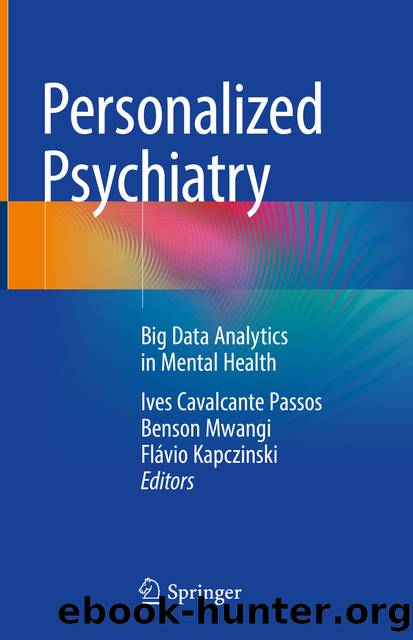Personalized Psychiatry by Unknown

Author:Unknown
Language: eng
Format: epub
ISBN: 9783030035532
Publisher: Springer International Publishing
5.8 Future Directions in Using ML for Suicide Risk Prediction
Although the studies reviewed above suggest that ML methods have considerable promise in predicting suicide, the field has as yet not fully realized that promise. A number of changes would likely improve prediction accuracy and clinical value. First, as illustrated in the last section, the feature sets used in the ML analyses of suicide carried out until now could be expanded beyond the structured EMR data that have so far been the mainstay of these analyses. In addition to the methods described in the last section, information on residential zip code could be used to extract small area geocode data from public sources on a number of important predictors of suicide such as local unemployment rates (Nordt et al. 2015) and neighborhood social capital (Holtkamp and Weaver 2018). Data from commercial search engines could be used to obtain more detailed socio-demographic information than the information on age, sex, and marital status typically available in EMRs and to extract information from public records on individual-level legal, financial, and criminal justice experiences that predict suicide (e.g., Accurint 2018).
Second, prediction accuracy could be improved by using ensemble ML methods combining individual-level predictions across algorithms. The Super Learner ensemble method, for example, has been shown to yield considerably higher levels of prediction accuracy than the best-performing algorithm in the ensemble (Polley et al. 2016). Automated machine learning (AutoML; Feurer et al. 2015; Olson et al. 2017) is also making it increasingly possible to refine feature transformation-pruning, algorithm selection, and hyperparameter tuning (Urbanowicz et al. 2017). AutoML can also be used to address the extreme imbalance problem by automatically implementing toolkits to evaluate the relative effectiveness of different imbalance correction methods (e.g., Chawla 2010).
Third, greater consideration is needed of the clinical value of different outcome time horizons in light of the fact that several studies have shown that optimal model features and coefficients differ depending on time horizon. In the ideal case, the time horizon would be chosen in light of the intervention the model is being designed to guide. This does not always occur. For example, the ML analysis described earlier predicting suicide among users of the VHA system was designed to facilitate VHA implementation of their Recovery Engagement And Coordination for Health-Veterans Enhanced Treatment (REACH VET) program (VA Office of Public and Intergovernmental Affairs 2017) among highest-risk VHA users. However, the ML model had a 30-day time horizon even though it often takes more than 30 days to make initial contact with the targeted Veteran and the program continues for at least 90 days. This raises the question whether the REACH VET ML model should have had a longer (e.g., 180-day) time horizon and, if so, the extent to which different Veterans would have been selected for intervention if this had been done.
Fourth, ML modeling efforts need to be better coordinated with the clinical interventions they are designed to support in ways other than time horizon. Most notably, ML model development up to now
Download
This site does not store any files on its server. We only index and link to content provided by other sites. Please contact the content providers to delete copyright contents if any and email us, we'll remove relevant links or contents immediately.
The Hacking of the American Mind by Robert H. Lustig(4332)
Right Here, Right Now by Georgia Beers(4158)
Fingerprints of the Gods by Graham Hancock(3960)
Goodbye Paradise(3757)
Bad Pharma by Ben Goldacre(3391)
Happiness by Matthieu Ricard(3015)
More Language of Letting Go: 366 New Daily Meditations by Melody Beattie(2994)
The Social Psychology of Inequality by Unknown(2982)
The Plant Paradox by Dr. Steven R. Gundry M.D(2576)
Drugs Unlimited by Mike Power(2560)
Confessions of a Shopaholic by Sophie Kinsella(2304)
Borders by unknow(2274)
Make Love Not Porn by Cindy Gallop(2076)
Dry by Augusten Burroughs(2068)
Stop Being Mean to Yourself: A Story About Finding the True Meaning of Self-Love by Melody Beattie(1960)
Getting Off by Erica Garza(1910)
Belonging by Unknown(1832)
Yoga and the Twelve-Step Path by Kyczy Hawk(1801)
Unmasking Male Depression by Archibald D. Hart(1779)
